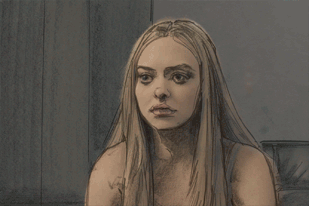Janet Hetherington talks to professionals about how, from courtroom dramas to science-fiction thrillers, vfx are playing bigger roles in current TV shows right from the beginning.

In the new ABC drama, Justice, defending counsel will ask a question of a witness, and as that witness replies, a virtual representation of the scene described in the response unfolds on-screen before the television viewers eyes.
No longer an afterthought in the production process, VFX are taking a lead role in shaping TV series, whether the action takes place in a laboratory, in outer space or in a staid courtroom setting.
You wouldnt think that a show like Justice would be so vfx-driven, but it really is, says Andrew Orloff, vfx supervisor, Zoic Studios. Zoic provides vfx for Justice as well as such shows as CSI, CSI: Miami, Blade, Prison Break and Eureka. Our challenge is to take complicated concepts and make them look fantastic, while moving the story forward. The key is to make the story clear to the viewer.
One of the ways to achieve first-rate vfx, combined with clear storytelling, on a television show budget is to be involved in the show from the earliest stages. Were heavily involved with the writers, Orloff adds, including the pitch part of the process. Writers want to know whats the coolest and hottest new technology, and what they can write into the show.
Armen Kevorkian, vfx supervisor for Ghost Whisperer, who works with co-supervisor Art Codron, contends that they receive script outlines before the scripts come out so they have an idea of whats in store. They also advise the production team of the realities of producing what the writers have conceived and how to handle complex shots.
With the television budget and schedules, we are able to weed out any potential vfx written that might not be doable, though nowadays with the talented artists we have, there are rarely cases when we say no, Kevorkian comments. There is a lot that goes into the pre-production on Ghost Whisperer, so even very complex shots are doable.

From Script to Ship
Generally the more sophisticated, or visual effects intensive, episodes involve us from a much earlier stage, agrees Bruce Woloshyn, digital effects supervisor, Rainmaker Animation and Visual Effects, which provides vfx for Stargate: Atlantis. The show has been picked up for another season on the SCI FI network.
With the Stargate: Atlantis pilot, Rising, we were involved from the green light of the project, Woloshyn suggests. For our team, that was literally script-to-ship.
In January of 2004, I received my script for the Rising pilot, Woloshyn remembers. It was so exciting to read through that first time. A flood of images and designs ran through my head as I read it. It was even more exciting, as we started meeting with the producing and design teams where our involvement at this very early stage was not only welcomed, but encouraged.
Woloshyn says the one thing that really differentiated the Atlantis pilot from the previous show SG-1 was the sheer amount of 3D modeling that had to be done. Every single model we needed, from the digital props and set pieces, to the spacecraft and city itself, had to be modeled from scratch, he adds. There would be no library of past seasons to draw on for this new show. It was with this huge amount of asset creation, where our input would be the most valued.
“CGI is very freeing,” adds Gary Hutzel, vfx supervisor for Battlestar Galactica. Hutzel, who came from a background of using miniatures for Star Trek: Deep Space Nine, is embracing the new technology with enthusiasm. “Our bread and butter is still space battles,” he says. “When you’re blowing up stuff a lot, you can’t keep on building and blowing up miniatures,” Hutzel laughs.
Hutzel, who is currently working with Vancouver’s Atmosphere to achieve effects, draws on his personal knowledge of the Galactica show when it comes to re-imagining spacecraft and characters. “We need to think through each effect,” Hutzel says. “We have to know how things work. We need to know where the drama is going to take the scene.”
Physical and Metaphysical
Today’s creators are diligent about having their vfx “grounded in reality.” Zoic’s Orloff notes that with such shows as CSI and CSI: Miami, everything is based on science, and the vfx— no matter how fancy or fanciful — must reflect the logical underpinnings of forensics. And while CSI and CSI: Miami are both crime dramas related by franchise, each show in the franchise must be differentiated. “Each show has its own palette,” Orloff says.
Some TV shows, like the new science-fiction series Eureka, envision advanced, not-yet-existent technology. Orloff says that the vfx team plays a strong role in developing the look of that technology and making it convincing, by using “internal logic” to conceive the vfx. Even with a horror/fantasy show like Blade, the vfx creators take care to ensure that the disintegration of the vampires, when they are spiked by the Day-Walker, reflects the way real charred bones would turn to dust.
For Ghost Whisperer, representations of ghosts are a primary effect shown in every episode, but vfx supervisor Kevorkian says that there “are a slew of different vfx” that appear as well. “In an upcoming episode, Melinda, played by Jennifer Love Hewitt, will have a house built around her, which is quite a challenge to do right, but looking at the preliminary animatics, we are very excited about how this sequence will turn out.

“In this case,” Kevorkian explains, “we brought in a storyboard artist early in the script stage and worked with him, the director and the producers to establish what this will look like and what we would need to shoot it. I think this is a very ambitious sequence for television, but knowing the talent pool that was available to us at our vendor, Eden FX, we were very confident we could pull it off. This sequence will probably come in at three weeks of work by our CGI artists.”
For Stargate: Atlantis, a key objective was to achieve realistic water effects. “The elements shoot for the Atlantis pilot was one of the most comprehensive elements shoot ever for the Stargate franchise,” says Rainmaker’s Woloshyn. “For instance, even though we were creating literally hundreds of passes of 3D particles in Maya for the sequence where the city of Atlantis rises up out of the ocean, we also knew that nothing looks more like water, than… well… real water.”
Woloshyn says that to facilitate some of the huge-scale water effects created to show the city’s massive pier decks breeching the surface, he turned to Wray Douglas and the special effects department. “Working to a scale drawing of the LightWave computer model of Atlantis’s pier E, Wray’s special effects department created a large-scale model of the pier out of industrial strength steel,” Woloshyn says. “This ‘black box’ model, over seven meters in length and weighing in at a little over two tonnes, would represent the virtual 625 meter pier as it broke the surface of the ocean. The massive steel model was then hauled to Vancouver’s False Creek, and repeatedly dropped into and lifted from the water by a huge construction crane. Filmed at 120 frames-per-second from a variety of angles, this large-scale model provided us with a tremendous library of water elements to composite into the city rising sequence.

So, although most of the visual effects work was done in the digital realm, Woloshyn comments, we certainly didnt limit ourselves to it. When considering the techniques for any of the shots, it was always about how best to achieve the end result be it practical, or digital.
Fresh and Flexible
Vfx creators are not only asserting early creative control of TV effects, they are also making a concerted effort to shape the way shows evolve. Zoics Orloff says that during the summer, when shows are in reruns or on hiatus, his team is busy meeting and working to prepare presentations incorporating the newest crop of dynamic effects. Thats when we take stock of all the new technology and try to raise the bar, adds Orloff.
Its a win-win situation. Seasoned shows such as CSI are offered new vfx possibilities by Zoic to keep things fresh, and the writers craft scripts that may include phrases like: Include cool Zoic effect here.
Vfx continue to play an important role at the end of a TV show as well as at the beginning. Hutzel of Battlestar Galactica says that his show needs the vfx to be flexible. A new director may want to try something new and different. With our show, the director can cut any way he wants, even if he wants to try something out of the style of the show.
And, while Galactica may take advantage of high-quality previs (Everyone gets a whack at it, Hutzel says), the vfx supervisor notes that shows can be rewritten in post to support new story elements or an emerging theme. Sometimes you have to be spontaneous and design vfx on the fly, he says.

Big, Big Vfx
As vfx become more integrated in TV shows, they are becoming a requirement for season premieres and finales, when the shows want to make a splash and snare ratings.
Season premieres and finales are traditionally the biggest shows of the year for SG-1, and its no different for Atlantis, says Rainmakers Woloshyn. However, the actual episodes are not necessarily shot in the order they air. In most cases, these effects heavy episodes especially the finales can be moved up in the shooting schedule to allow for more time to execute not only the more intricate shots, but generally the much larger volume of effects shots.
Premieres and finales are generally much bigger in nature, as it should be, notes Ghost Whisperers Kevorkian. Theyre your bookends to the season, and the fans have come to expect this.
This years season premiere, which is basically the first two episodes, had over 140 vfx shots, advises Kevorkian. Just coming off seeing them in final form with final effects and music, I have to say its like a mini-feature.
I think it is very important for us to be involved in the early creative process and the good thing is that most producers I have worked with realize this, Kevorkian says. Its nice to be able to advise as to what can be accomplished well and what might look hokey. We have a lot of support from production when we shoot our plates; they really make sure we get all that we need. This is why it is important for vfx-heavy shows to have a staff vfx supervisor to advise and protect the interests of the show, with quality and budget in mind.

Rainmakers Woloshyn, too, believes that asserting early creative control can have a profound effect on successful vfx. The rapport, and understanding of the vision of the shows creative team, is one of the most important factors on any project, he says. Its not so much about establishing control as it is about demonstrating a competence in your craft to production to establish an honest working relationship.
Ive always felt very strongly about stressing that although incredible advancements in technology have allowed us unprecedented control in the images we create, that it is important that everyone understands that its the people that create these images, not the technology. Its not really so much about establishing control as it is trust.
Janet Hetherington is a freelance writer and cartoonist based in Ottawa, Canada. She shares a studio with artist Ronn Sutton and a ginger cat, Heidi.








